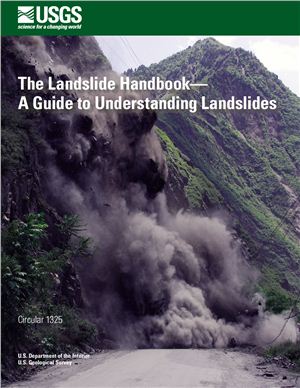Lynn M. Highland, United States Geological Survey, and Peter
Bobrowsky, Geological Survey of Canada
U.S. Geological Survey, Reston, Virginia: 2008
Introduction
This handbook is intended to be a resource for people affected by landslides to acquire further knowledge, especially about the conditions that are unique to their neighborhoods and communities. Considerable literature and research are available conceing landslides, but unfortunately little of it is synthesized and integrated to address the geographically unique geologic and climatic conditions around the globe. Landslides occur throughout the world, under all climatic conditions and terrains, cost billions in monetary losses, and are responsible for thousands of deaths and injuries each year. Often, they cause long-term economic disruption, population displacement, and negative effects on the natural environment.
Outdated land-use policies may not always reflect the best planning for use of land that is vulnerable to landslides. The reasons for poor or nonexistent land-use policies that minimize the perceived or actual danger and damage potential from geologic hazards are many and encompass the political, cultural, and financial complexities and intricacies of communities. Landslides often are characterized as local problems, but their effects and costs frequently cross local jurisdictions and may become State or Provincial or national problems.
Growing populations may be limited in their geographic expansion, except to occupy unstable, steep, or remote areas. Often, stabilizing landslide-scarred areas is too costly, and some inhabitants have no other places to relocate. Fortunately, simple, low-tech precautions and actions can be adopted to at least ensure an individual’s immediate safety, and this handbook gives a brief overview of many of these options. We strongly suggest that, where possible, the assistance of profes-sional engineers/geologists or those experienced in the successful mitigation of unstable slopes be consulted before actions are taken. This handbook helps home-owners, community and emergency managers, and decisionmakers to take the positive step of encouraging awareness of available options and recourse in regard to landslide hazard.
U.S. Geological Survey, Reston, Virginia: 2008
Introduction
This handbook is intended to be a resource for people affected by landslides to acquire further knowledge, especially about the conditions that are unique to their neighborhoods and communities. Considerable literature and research are available conceing landslides, but unfortunately little of it is synthesized and integrated to address the geographically unique geologic and climatic conditions around the globe. Landslides occur throughout the world, under all climatic conditions and terrains, cost billions in monetary losses, and are responsible for thousands of deaths and injuries each year. Often, they cause long-term economic disruption, population displacement, and negative effects on the natural environment.
Outdated land-use policies may not always reflect the best planning for use of land that is vulnerable to landslides. The reasons for poor or nonexistent land-use policies that minimize the perceived or actual danger and damage potential from geologic hazards are many and encompass the political, cultural, and financial complexities and intricacies of communities. Landslides often are characterized as local problems, but their effects and costs frequently cross local jurisdictions and may become State or Provincial or national problems.
Growing populations may be limited in their geographic expansion, except to occupy unstable, steep, or remote areas. Often, stabilizing landslide-scarred areas is too costly, and some inhabitants have no other places to relocate. Fortunately, simple, low-tech precautions and actions can be adopted to at least ensure an individual’s immediate safety, and this handbook gives a brief overview of many of these options. We strongly suggest that, where possible, the assistance of profes-sional engineers/geologists or those experienced in the successful mitigation of unstable slopes be consulted before actions are taken. This handbook helps home-owners, community and emergency managers, and decisionmakers to take the positive step of encouraging awareness of available options and recourse in regard to landslide hazard.

